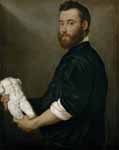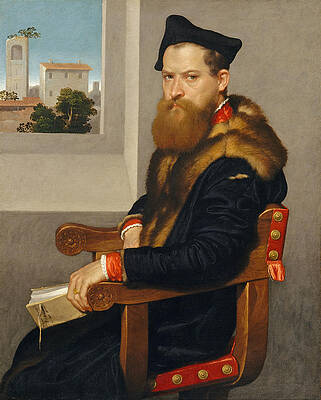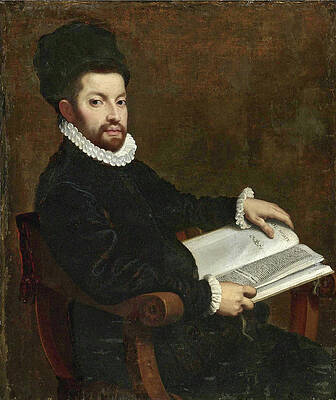Giovanni Battista Moroni
Paintings
The Tailor. Il Tagliapanni
Gian Federico Madruzzo
Gian Federico Madruzzo
Portrait of a Lady
Bust Portrait of a Magistrate
The Vestal Virgin Tuccia
A Knight with his Jousting Helmet
Portrait of a Man
The Magistrate
Portrait of a Young Woman
The Resurrection Of Christ
Bust Portrait of a Young Man with an Inscription
Canon Ludovico di Terzi
Portrait of a Gentleman. Il Gentile Cavaliere
Portrait of a Gentleman
Portrait of a Soldier
The Knight in Black
Portrait of a Man holding a Letter. L'Avvocato
Portrait of Leonardo Salvagno
Lucrezia Agliardi Vertova
Portrait of Ercole Tasso

The Sculptor Alessandro Vittoria

Portrait of a Gentleman (Il Gentile Cavaliere)

Portrait of a Man with Raised Eyebrows
Fine Art Prints | Greeting Cards | Phone Cases | Lifestyle | Face Masks | Men's , Women' Apparel | Home Decor | jigsaw puzzles | Notebooks | Tapestries | ...
The Vestal Virgin Tuccia
Giovanni Battista Moroni (c. 1520/24[1] – February 5, 1579) was a North Italian painter of the Late Renaissance period. He is also called Giambattista Moroni. Best known for his elegantly realistic portraits of the local nobility and clergy, he is considered one of the great portrait painters of sixteenth century Italy.
Biography
Portrait of the sculptor Alessandro Vittoria, painting by Giovanni Battista Moroni, 1552-3, Kunsthistorisches Museum
The Tailor, painting by Giovanni Battista Moroni, 1570–1575, National Gallery (London)
The son of an architect, Andrea Moroni, he trained under Alessandro Bonvicino "Il Moretto" in Brescia, where he was the main studio assistant in the 1540s, and worked in Trent, Bergamo and his home town of Albino, near Bergamo, where he was born and died. His two short periods in Trento coincided with the first two sessions of the Council of Trent, 1546–48 and 1551–53. On both occasions Moroni painted a number of religious works (including the altarpiece of the Doctors of the Church for the church of Santa Maria Maggiore, Bergamo) as well as the series of portraits for which he is remembered.
During his stay in Trent he also made contact with Titian and the Count-Bishop, Cristoforo Madruzzo, whose own portrait is by Titian but for whom Moroni painted portraits of his sons.[2] There were nineteenth-century claims that he was trained by Titian at Trento; however, it is improbable he ever ventured to the Venetian's studio for long, if at all. Moroni's period as the fashionable portraitist of Bergamo, nowhere documented but in the inscribed dates of his portraits, is unexpectedly condensed, spanning only the years ca. 1557–62, after which Bergamo was convulsed in internecine strife and Moroni retired permanently to Albino, (Rossi, Gregori et al.) where, in his provincial isolation, he was entirely overlooked by Giorgio Vasari. His output at Bergamo, influenced in part by study of the realism of Savoldo, produced in the few years a long series of portraits that, while not quite heroic, are full of dignified humanity and grounded in everyday life. The subjects are not drawn exclusively from the Bergamasque aristocracy, but from the newly self-aware class of scholars and professionals and exemplary government bureaucrats, with a few soldiers, presented in detached and wary attitudes with Moroni's meticulous passages of still life and closer attention to textiles and clothing than to psychological penetration.
His output of religious paintings, destined for a less sophisticated audience in the local sub-Alpine valleys, was smaller and less successful: "the exact truth of parts nowhere added up, in his altar pictures, even to the semblance of credibility," Freedberg has observed of their diagrammatic schemes borrowed from Moretto and Savoldo and others.[3] for example, he painted a Last Supper for the parish at Romano in Lombardy; Coronation of the Virgin in Sant'Alessandro della Croce, Bergamo; also for the cathedral of Verona, SS Peter and Paul, and in the Brera Academy of Milan, the Assumption of the Virgin. Moroni was engaged upon a Last Judgment in the church of Gorlago, when he died. Overall, his style in these paintings shows influences of his master, Lorenzo Lotto, and Girolamo Savoldo. Giovanni Paolo Cavagna was an undistinguished pupil of Moroni; however, it is said that in following generations, his insightful portraiture influenced Fra' Galgario and Pietro Longhi.
S.J. Freedberg notes that while his religious canvases are "archaic", recalling the additive compositions of the late Quattrocento and show stilted unemotive saints, his portraits are remarkable for their sophisticated psychological insight, dignified air, fluent control and exquisite silvery tonality. Patrons for religious art were not interested in an individualized, expressive "Madonna"; they desired numinous archetypal saints. On the other hand, patrons were interested in the animated portraiture.
Public collections with works by Moroni
The National Gallery (London) has one of the best collections of his work, including the celebrated portrait known as Il Sarto (The Tailor). Other portraits are found in the Uffizi (the Nobleman Pointing to Flame inscribed "Et quid volo nisi ut ardeat?"), Berlin Gallery, the Canon Ludovico de' Terzi and Moroni's self-portrait; and in the National Gallery, Washington, the seated half-figure of the Jesuit Ercole Tasso, traditionally called "Titian's Schoolmaster", although there is no real connection with Titian.
The Accademia Carrara (Bergamo) (Portrait of an old man). Ashmolean Museum (University of Oxford), Brooks Museum of Art (Memphis, Tennessee), Detroit Institute of Arts, the Fine Arts Museums of San Francisco, the Hermitage Museum, the Honolulu Museum of Art, Kunsthistorisches Museum (Vienna), the Liechtenstein Museum (Vienna), the Musée du Louvre, Musée Condé Chantilly (Chantilly, France), Museo Poldi Pezzoli (Milan), the Museum of Fine Arts, Boston, National Galleries of Scotland, the National Gallery of Art (Washington D.C.), the National Gallery of Australia, the National Gallery of Canada (Portrait of a Man),[4] the National Gallery, London, the Norton Simon Museum (Pasadena, California), Pinacoteca Ambrosiana (Milan), Pinacoteca di Brera (Milan), Rijksmuseum, the Ringling Museum of Art (Florida), Studio Esseci (Padua, Italy), University of Arizona Museum of Art, Virginia Museum of Fine Arts, National Gallery of Ireland (Portrait of a Gentleman and his two Children) and the Uffizi (Portrait of Giovanni Antonio Pantera) are among the public collections holding works by Giovanni Battista Moroni.[5]
References and sources
References
The 1911 Britannica placed his birth date around 1510; Freedberg states he was born ca 1523, while the Bergamo exhibition gives the range 1520/24.
They are at the Art Institute of Chicago and the National Gallery of Art, Washington.
Freedberg 1993:593.
https://www.gallery.ca/en/see/collections/artwork.php?mkey=12770
The old monographs on Moroni by D. Cugini Moroni Pittore (Bergamo) 1939 and G. Lendorff Giovanni Battista Moroni Il Ritrattista Bergamasco (Bergamo) 1939 have been superseded; archival notices concerning the painter and the modern catalogue raisonné is in Mina Gregori, Giovanni Battista Moroni: tutte le opere (Bergamo) 1979; two exhibitions have renewed interest in Moroni: Francesco Rossi, Mina Gregori et al., Giovan Battista Moroni (Bergamo exhibition catalogue), and Peter Humfrey, Giovanni Battista Moroni: Renaissance Portraitist (Fort Worth: Kimball Art Museum) 2000, the catalogue record of an exhibition of ten portraits at the Kimball (February–May 2000), with essays that set Moroni in the cultural history of his time.
Sources
Wittkower, Rudolf (1993). "Art and Architecture Italy, 1600–1750". Pelican History of Art. 1980. Penguin Books. pp. 591–595.
Freedberg, S.J. (1993). Painting in Italy 1500–1600. 3rd ed. 1993. Yale University Press. pp. 591–95.
----
Fine Art Prints | Greeting Cards | Phone Cases | Lifestyle | Face Masks | Men's , Women' Apparel | Home Decor | jigsaw puzzles | Notebooks | Tapestries | ...
----
Artist
A - B - C - D - E - F - G - H - I - J - K - L - M -
N - O - P - Q - R - S - T - U - V - W - X - Y - Z
Retrieved from "http://en.wikipedia.org/"
All text is available under the terms of the GNU Free Documentation License























